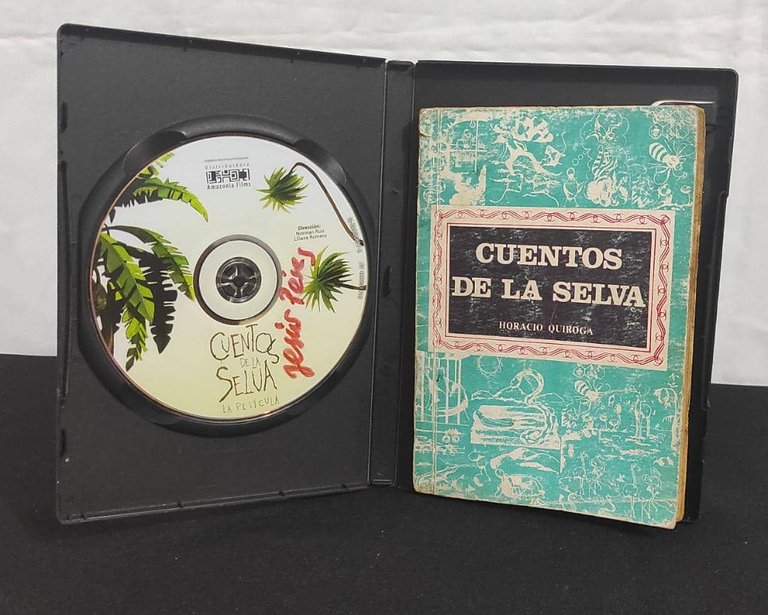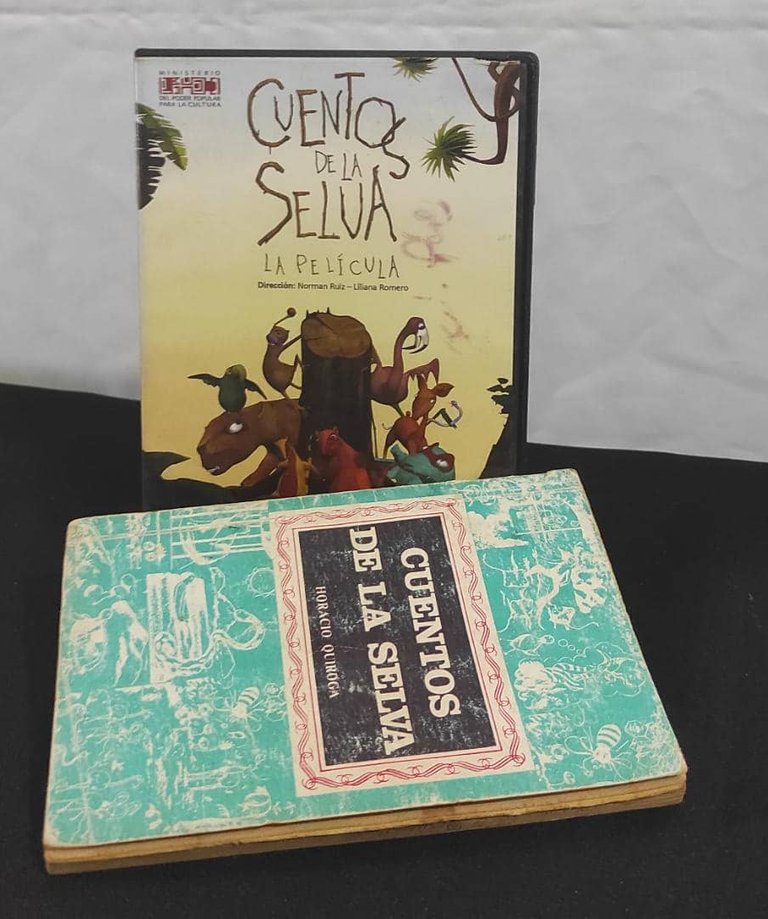

Tres anécdotas sobre un mismo libro
Ahora que he releído Cuentos de la selva, de Horacio Quiroga, me llegan a la memoria tres anécdotas relacionadas con este libro, de tres momentos diferentes y que me apasiona contar porque aparte de que me encanta releer, tengo la dicha de que siempre me suceden cosas relacionadas con libros y escritores, que sin duda me han servido para que mi amor por los libros crezca y mi relación con ellos sea más interesante. Veamos:
La primera viene del año 2007. Para entonces yo era maestro de un grupo de 40 niños en una unidad educativa que tiene por nombre, “Dr. José María Vargas”. Los niños estaban en 4to. grado y yo en mi 4to. año de experiencia como docente; habíamos seleccionado a Cuentos de la selva para leerlo en clase porque trata de animales, de la selva y porque un amigo me obsequió para le época, una película de Amazonía Films que versionaba el libro mencionado. La dirigieron Norma Ruiz y Liliana Romero, pero no la vimos hasta que no terminamos de leer el libro y para emoción de los chicos fuimos a verla en la que fue la Cinemateca Nacional, de mi ciudad, Guanare; de modo que hubo que contratar un autobús, preparar las palomitas de maíz, y llevar a un par de padres y representantes para que ayudaran con la seguridad de los pequeños.
Fue una experiencia única para los niños. Leer un libro, salir a ver la película y luego comentar las diferencias entre la lectura y el cine; fue propicia la ocasión para resaltar la lectura como fuente principal de la imaginación, de la creatividad y de lo feliz que podemos ser cuando aprendemos a leer sintiendo lo que el autor quiere trasmitir.
La segunda viene de mi época en que viví en la selva colombiana, en Inírida, capital del departamento del Guainía. Eso fue en el 2018, hace 4 años. Vivía en casa de un amigo, un profesor que luego se casó con una amiga a la que yo le presenté, y esta amiga tenía una hija que tenía 6 años y era una excelente lectora. Se llama Luciana y se levantaba a las 5 de la mañana a leer; en Inírida oscurece a las 5 de la tarde por eso la gente se acuesta temprano y se levanta a esa hora, y esta niña que le apasionan los libros de Anthony Browne me encontró un día leyendo Cuentos de la selva y me dijo que le dijera de qué trataba; yo no le quise decir, en cambio le prometí que comenzaría a leérselo y quedamos que al siguiente día comenzaríamos. A las 5 de la mañana la niña estaba esperando por mí y comenzamos con La tortuga gigante y finalizamos tres día después con El regreso de Anaconda.
La tercera es más reciente, viene de hace una semana cuando en casa, estábamos reunidos el equipo de la @abejaobrera; organizando lo que sería la conmemoración del Día del Libro, bromeábamos entre nosotros quién era la abeja que menos publicaba, quién la que menos votos recibía y quién era la más floja; de inmediato recordé el cuento La abeja haragana, que se encuentra en este libro y que es uno de los más bonitos por su mensaje, por al lección edificante que nos deja. Recuerdo que lo comentamos y de ahí se me ocurrió volver a releer el libro.
Sin duda que, al que buen libro se arriba, buenas luces lo cobijan, y a mí si no me encuentran leyendo, me encuentran escribiendo o hablando de lo que me gusta y desde niño siempre me han gustado los libros, y ahora que estoy en esta plataforma no puedo dejar de comentar mis experiencias lectoras porque sería detener la conversación; verán, cuando un escritor tiene la idea para un libro, primero empieza a conversar con su narrador, que es el personaje más importante en la ficción, luego el narrador va contándonos las conversaciones entre los demás personajes: protagonistas, antagonistas y personajes secundarios; finalmente llega el lector que se sienta o se acuesta para empezar a escuchar lo que el autor le dice, porque la lectura es un diálogo entre autor y lector; el primero configura la historia, el segundo la refigura y en esa relación la historia adquiere su verdadera significación, pero además, esta conversación se puede extender para el buen funcionamiento de la lectura y se hace cuando el lector, como es mi caso, escribe sus experiencias lectoras abriendo nuevamente el ciclo del diálogo.


Three anecdotes about the same book
Now that I have reread Tales of the Jungle, by Horacio Quiroga, three anecdotes related to this book come to my memory, from three different moments and that I am passionate about telling because apart from the fact that I love rereading, I am fortunate that things always happen to me related to books and writers, which have undoubtedly served to make my love for books grow and my relationship with them more interesting. Let's see:
The first one comes from the year 2007. At that time I was a teacher of a group of 40 children in an educational unit named "Dr. José María Vargas". The children were in 4th grade and I was in my 4th year of teaching experience; we had selected Tales of the Jungle, to read it in class because it deals with animals, the jungle and because a friend gave me a movie from Amazonía Films that was a version of the book mentioned above. It was directed by Norma Ruiz and Liliana Romero, but we did not see it until we finished reading the book and to the excitement of the children we went to see it in what was the National Cinematheque, in my city, Guanare; so we had to hire a bus, prepare the popcorn, and take a couple of parents and representatives to help with the safety of the children.
It was a unique experience for the children. Reading a book, going out to see the movie and then commenting on the differences between reading and cinema; it was a propitious occasion to highlight reading as the main source of imagination, creativity and how happy we can be when we learn to read by feeling what the author wants to transmit.
The second comes from my time living in the Colombian jungle, in Inírida, capital of the department of Guainía. That was in 2018, 4 years ago. I lived at a friend's house, a professor who later married a friend whom I introduced him to, and this friend had a daughter who was 6 years old and an excellent reader. Her name was Luciana and she got up at 5 in the morning to read; in Inírida it gets dark at 5 in the afternoon that is why people go to bed early and get up at that time, and this girl who was passionate about Anthony Browne's books found me one day reading Tales of the Jungle and told me to tell her what it was about; I did not want to tell her, instead I promised her that I would start reading it to her and we agreed that the next day we would start. At 5 o'clock in the morning the girl was waiting for me and we started with The Giant Tortoise and finished three days later with The Return of Anaconda.
The third is more recent, it comes from a week ago when at home, the @abejaobrera team was gathered; organizing what would be the commemoration of the Book Day, we joked among ourselves about who was the bee that published the least, who received the least votes and who was the laziest; I immediately remembered the story The lazy bee, which is in this book and which is one of the most beautiful for its message, for the uplifting lesson it leaves us. I remember that we commented on it and from there it occurred to me to reread the book
Without a doubt, if you look for me you find me reading, you find me writing or talking about what I like and since I was a child I have always liked books, and now that I am on this platform I can not stop commenting on my reading experiences because the conversation would end, you see, when a writer has the idea of a book, first he starts talking to his narrator, who is the most important character in fiction, then the narrator tells us the conversations between the other characters: protagonists, antagonists and secondary characters; finally comes the reader who sits or lies down to start listening to what the author tells him, because reading is a dialogue between author and reader, the first configures the story, the second refigures it and in that relationship the story acquires its true meaning, but in addition, this conversation can be expanded for the proper functioning of the reading and it is done when the reader, as is my case, writes his reading experiences opening again the cycle of dialogue.

Texto e imagen de / Text and image by
@jesuspsoto
~~~ embed:1510973523468115972 twitter metadata:amFscDIxfHxodHRwczovL3R3aXR0ZXIuY29tL2phbHAyMS9zdGF0dXMvMTUxMDk3MzUyMzQ2ODExNTk3Mnw= ~~~
The rewards earned on this comment will go directly to the person sharing the post on Twitter as long as they are registered with @poshtoken. Sign up at https://hiveposh.com.
Dilecto amigo, un "refresh" de Lunes tempranero leerte... Como siempre, líneas encantadoras que delatan ingenuidades de alma buena, matizadas con el intelecto sobresaliente de aquellos que llevan un paso por delante a los comunes. Feliz Semana @jesuspsoto
Hola, amigo. Te llamas Jesús, ¿cierto?, somos tocayo. Mezclo mis experiencias en lo que escribo para darle más sentido, para que hacerlo más creíble, darle lo que decía Aristóteles, verosimilitud. Es un placer tenerte siempre de visita.
Eso es correcto tocayo... Jesús Linares para servirle... El placer es mío al leer cuando escribes... Que tengas un excelente día y que la creatividad te abunde...
@tipu curate 6
Upvoted 👌 (Mana: 0/55) Liquid rewards.
Gracias, @yonnathang
Este libro o conozco porque en una oportunidad leí un par de cuentos, toca retomarlo.
Un par de cuentos es bastante, pero todo e libro es doblemente bastante. Gracias por la lectura